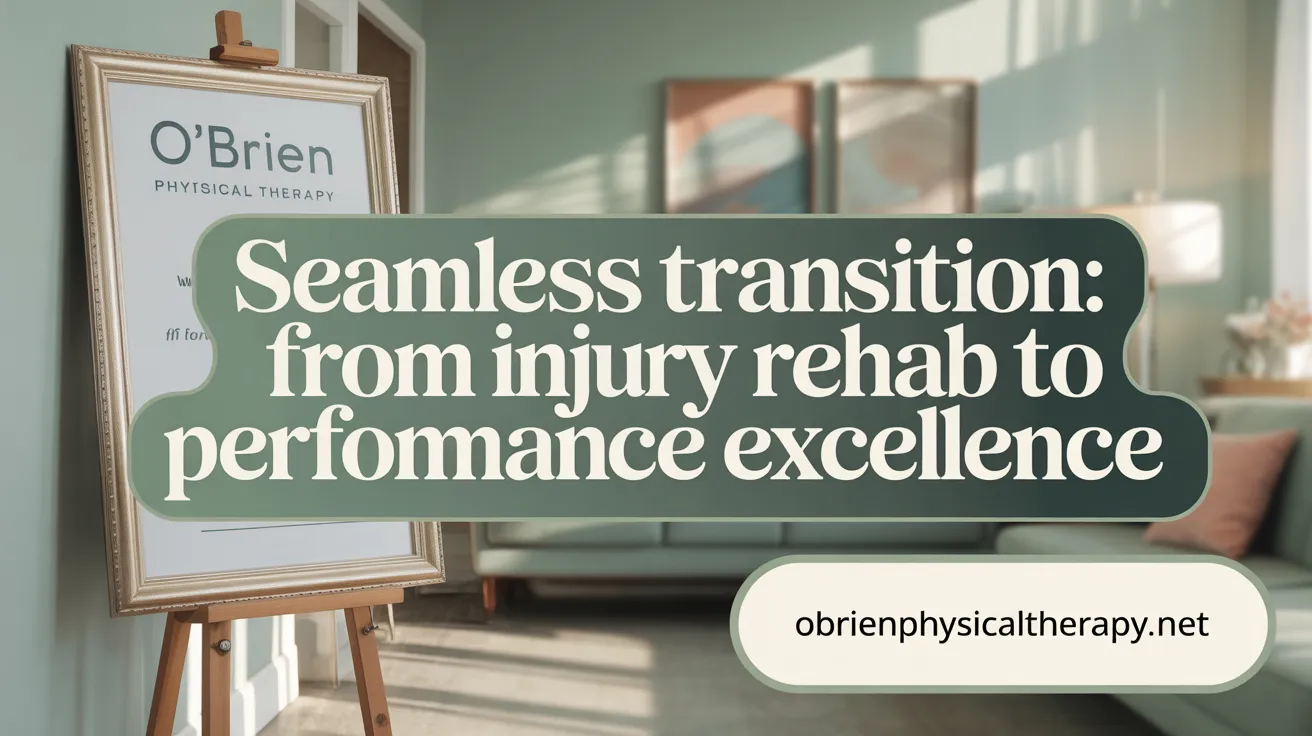Physical Therapy: Beyond Injury Recovery to Peak Performance
Physical therapy (PT) has long been recognized for its crucial role in injury recovery. However, its value extends well beyond rehabilitation, encompassing performance enhancement, injury prevention, and personalized athletic development. This article explores how PT serves not only athletes but anyone looking to optimize physical function, detailing the ways PT improves athletic performance through science-backed assessments, targeted training, and innovative recovery approaches.
Expanding the Role of Physical Therapy: From Recovery to Performance Optimization

How does performance physical therapy differ from traditional physical therapy?
Traditional physical therapy primarily aims to restore an individual’s baseline function after injury, focusing on healing and regaining normal daily or sports-related activities. In contrast, performance physical therapy goes beyond simple recovery. It prioritizes enhancing and optimizing the body's capacity, targeting improvements in strength, mobility, balance, and overall athletic performance.
This proactive approach not only speeds up recovery but also helps in preventing future injuries by addressing weaknesses and functional limitations before they lead to problems. Performance physical therapists use specialized assessments to identify areas for improving physical capabilities, preparing individuals to perform better and more safely than before.
What does 'function' and 'performance' mean in the context of physical therapy?
In physical therapy, function refers to the actual activities and movements a person can perform—this includes everyday tasks like walking or climbing stairs, as well as sports-specific actions such as running, jumping, or throwing.
Performance, on the other hand, measures how well those functions are executed. It encompasses the quality, efficiency, strength, and skill involved in carrying out a movement or activity. Enhancing performance means improving these factors to enable a person to perform at a higher level, regardless of whether they are an elite athlete, recreational player, or simply active in daily life. This distinction is well explained in sports physical therapy literature.
How does performance physical therapy take a proactive role?
Unlike traditional therapy, which often waits until after an injury has happened, performance physical therapy emphasizes injury prevention by proactively increasing the body's capacity. Therapists assess movement patterns, muscle imbalances, and joint mobility to develop customized programs that optimize performance and reduce risk factors.
Through targeted exercises and strength training, therapists build endurance, power, and control, helping individuals move more efficiently. This forward-thinking strategy minimizes the chances of recurring injuries and promotes long-term athletic development, as highlighted in injury prevention and performance enhancement resources.
What assessment techniques are used to enhance performance?
Performance physical therapists employ a variety of diagnostic tools:
- Special tests: Originally designed for injury diagnosis, these also assess strength, flexibility, and balance (source).
- Biomechanical analysis: Evaluates movement patterns to identify inefficiencies or compensations (source).
- Functional evaluations: Measure joint stability, muscular endurance, and neuromuscular control (source.
These assessments inform personalized training plans that address weaknesses and improve coordination, resulting in enhanced athletic performance and reduced injury risk.
How does enhanced performance help prevent injuries?
Improving performance means building a stronger, more balanced, and flexible body capable of handling sports or daily demands more effectively. Enhanced strength and mobility distribute forces more evenly during activities, reducing undue stress on certain joints or muscles.
By correcting improper movement patterns and strengthening vulnerable areas, performance physical therapy lowers the likelihood of common sports injuries such as sprains, strains, and overuse injuries. This combination of performance enhancement and injury prevention fosters safer, more sustainable physical activity for athletes and active individuals alike.
Customized Physical Therapy Programs: Targeting Strength, Flexibility, and Movement Efficiency

How do physical therapists develop programs to improve athletic performance?
Physical therapists design personalized exercise programs by thoroughly analyzing an athlete's biomechanics, injury history, and the specific demands of their sport. Using this information, they identify muscle imbalances, and movement dysfunctions that may limit performance or increase injury risk. Programs then focus on strengthening weak areas, improving flexibility, and enhancing core stability to support efficient and safe movements. Gait analysis and movement pattern assessments help therapists target inefficiencies and correct improper mechanics. Integrating hands-on manual therapy and specialized modalities complements exercise interventions by managing pain and improving mobility, helping athletes achieve optimal performance.
What injury prevention measures does physical therapy emphasize?
Injury prevention in physical therapy centers on addressing vulnerabilities before they develop into injury. Therapists emphasize proper warm-up and cool-down routines that include dynamic stretching to prepare muscles and joints for activity. Balance and proprioceptive exercises specifically target stability, reducing the likelihood of falls or sprains. Strength conditioning focuses on muscles that support joints prone to injury, preventing overuse and compensatory patterns. Regular screening helps detect imbalances early, allowing therapists to implement focused corrective exercises. This proactive approach not only lowers injury risk but also enhances athletic longevity and performance.
Physical therapists apply a comprehensive, sport-specific methodology to customize rehabilitation and performance training. This targeted strategy leads to improved strength, flexibility, core stability, and movement efficiency—critical components for peak athletic output and sustained health.
Physical Therapy in Rehabilitation and Performance Transition

How does physical therapy support athletes during injury rehabilitation?
Sports physical therapy plays a crucial role in injury rehabilitation, managing pain, restoring mobility, rebuilding strength, and enhancing coordination. Rehabilitation typically progresses through stages, beginning with pain and inflammation control, then restoring range of motion, followed by strength and balance training, and finally sport-specific functional drills. Therapists utilize evidence-based techniques such as manual therapy, therapeutic exercises, and modalities like electrical stimulation, ultrasound, and cryotherapy to speed healing and reduce discomfort. Personalized programs ensure athletes regain movement and physical capacities tailored to their sport.
What is the importance of transitioning from rehab to performance training?
Transitioning from rehabilitation to performance training is vital for athletes to not only return to pre-injury function but also to exceed it safely. This shift includes progressively increasing training intensity and incorporating sport-specific drills that enhance speed, agility, endurance, and strength. Structured rehab-to-performance programs mitigate the risk of re-injury by addressing muscle imbalances, and faulty movement patterns uncovered during rehab. They build confidence and psychological readiness supporting a safe and effective return to full competition.
Tailored post-injury training to return safely to sport
Post-injury programs are customized according to injury type, sport demands, and athlete goals. Late-stage rehab incorporates plyometrics, deceleration drills, change of direction exercises, and endurance training specific to the athlete's sport (return to sport rehabilitation). Movement pattern analysis guides corrective exercises to optimize biomechanics and prevent compensations. Continuous assessment ensures athletes meet criteria in strength, stability, functional movement, and mental preparedness before full return.
Use of advanced recovery modalities and techniques
Advanced modalities such as red light therapy, compression therapy, antigravity treadmills, photobiomodulation, and manual therapy enhance recovery outcomes. These methods reduce inflammation, improve circulation, and support tissue healing, allowing athletes to progress safely through rehabilitation stages. Integrating technology with traditional techniques fosters faster and more effective recovery.
Psychological readiness and confidence building during rehab
Physical therapy emphasizes psychological factors alongside physical restoration. Reducing pain and restoring function can alleviate injury-related anxiety. Therapists incorporate mental support and education, empowering athletes to trust their bodies and movement mechanics. Confidence gained through successful completion of progressive rehab milestones is essential for readiness to return to sport.
Recovery, Nutrition, and Mental Strategies in Physical Therapy for Athletic Success
What recovery methods do physical therapists recommend to improve athletic performance?
Physical therapy incorporates scientifically backed recovery strategies to help athletes rebuild strength and enhance performance. Key strategies include:
- Adequate Rest and Active Rest: Sufficient rest allows muscles to repair, while active rest involves light activities that increase blood circulation and clear metabolic waste.
- Nutrition and Hydration: Balanced intake of carbohydrates, proteins, and healthy fats supports energy replenishment and tissue repair. Hydration regulates body functions critical for endurance. Learn more about proper nutrition for athletes.
- Specialized Therapies: Techniques such as cryotherapy (cold exposure), photobiomodulation (red and near-infrared light therapy), and compression therapy are used to reduce inflammation, accelerate healing, and improve muscle recovery.
These approaches work synergistically to minimize downtime and optimize an athlete's recovery phase, ultimately leading to better training adaptations and injury prevention.
How do mental and nutritional factors integrate with physical therapy to boost performance?
Physical therapists emphasize a holistic approach combining mental training with nutrition to complement physical rehabilitation and performance enhancement:
- Mental Training Techniques: Visualization, mindfulness, positive self-talk, and goal-setting help increase focus, confidence, and psychological resilience essential for high-level athletic performance.
- Nutrition: Customized meal plans rich in carbohydrates (energy), proteins (muscle repair), and healthy fats (hormone balance) are critical. Adequate calorie intake prevents conditions like low energy availability, which can increase injury risk. See detailed guidance on turbocharging athletic performance through nutrition.
Together, these mental and nutritional strategies improve recovery efficiency, maintain motivation, and enhance physical outcomes during and after therapeutic intervention.
Why are sleep and rest critical in physical regeneration?
Sleep is foundational for physical therapy success and athletic recovery. Quality and quantity of sleep enable muscle repair, memory preservation, hormonal balance, and reduce injury risk. Consistent sleep schedules and environmental adjustments enhance these restorative effects, supporting the gains achieved through physical therapy. For a comprehensive look at hydration and recovery's role in athletic performance, see Athletic Performance Improvement.
How does technology support recovery and training optimization?
Modern athletes benefit from wearable devices and monitoring tools that track sleep quality, hydration levels, and workout performance. These technologies provide real-time feedback, allowing therapists and athletes to adjust training loads and recovery protocols dynamically, ensuring optimal progression while mitigating injury risks. Discover more about innovations in physical therapy and sports medicine and physical therapy’s role in boosting athletic performance.
Holistic and Multidisciplinary Approach: Physical Therapy’s Comprehensive Impact on Athletic Performance

How does physical therapy integrate into a multidisciplinary team to enhance athletic performance?
Physical therapy plays a critical role within a multidisciplinary team by working closely with sports doctors, nutritionists, orthopedic specialists, and mental health professionals. This coordinated approach allows physical therapists to tailor treatment plans that address not only the physical rehabilitation needs but also nutritional and psychological aspects of the athlete’s health.
By integrating expertise from various disciplines, athletes receive comprehensive care that supports injury recovery, optimizes training techniques, enhances overall wellbeing, and reduces the risk of future injuries. For example, nutritionists help guide diet plans that fuel recovery and performance, while mental health support fosters resilience and confidence. This combined effort results in superior athletic outcomes across all levels of competition.
What are the benefits of physical therapy for athletes beyond injury treatment?
Physical therapy extends well beyond just treating injuries. It enhances strength, flexibility, balance, and movement mechanics, which collectively improve athletic performance and efficiency. Physical therapists develop personalized training programs that address specific sport requirements and individual physical conditions, ensuring better fitness and skill development.
Athletes also benefit from education on injury prevention strategies and self-management techniques, empowering them to maintain long-term health and durability. Furthermore, physical therapy supports mental health by boosting confidence through pain relief, improved function, and successful rehabilitation milestones, contributing positively to overall performance.
Through the use of advanced diagnostic tools and cutting-edge interventions like gait analysis, manual therapy, and neuromuscular training, physical therapy ensures targeted and effective care. This holistic and comprehensive approach benefits amateur athletes and professionals alike, promoting peak performance, longevity in sports, and a healthier athletic lifestyle.
Physical Therapy: A Key to Unlocking Athletic Excellence
Physical therapy transcends the traditional role of injury management, evolving into a cornerstone for enhancing athletic performance and longevity. Through personalized assessment, targeted training, comprehensive rehabilitation, advanced recovery methods, and multidisciplinary collaboration, physical therapy empowers athletes to overcome limitations, prevent injuries, and exceed performance expectations. Its integration of physical, nutritional, and mental strategies ensures a holistic pathway to athletic excellence, making PT an indispensable partner for anyone aspiring to perform at their best.
